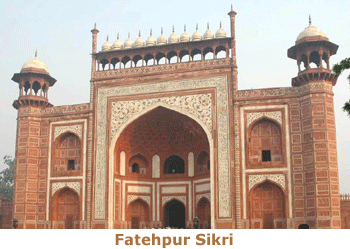FATEHPUR SIKRI................................................................................................................................................................................................................................................................................... Sikri an extension of the upper Vindhyan ranges is situated on the bank of a large natural lake, which has now mostly dried up. It is a pre-historic site and, with abundant water, forest and raw material, it was ideal for primitive man’s habitation. Rock shelters with paintings exist on the periphery of the lake. Stone age tools have been found in this area. Ochre Coloured Pottery (c. 2nd millennium B.C.) and Painted Grey Ware (c.1200-800 B.C.) have also been discovered from here. Sikri has been mentioned in the Mahabharata as ‘Saik’. Lexicons define ‘Saik’ as a region surrounded by water. An inscription found on the stone sculpture of Jaina Saraswati (dated 1067 Vikram Samvat = 1010 A.D.) mentions this place as ‘Sekrikya’, which seems to be a similar derivative. All this shows that Sikri was continuously inhabited since the prehistoric period. Babur visited the place on the eve of the Khanwah battle in A.D. 1527 and mentioned it as ‘Sikri’ in his Memoirs. He founded here a garden and a Jal-Mahal surrounded by the lake-water, and a baoli (step-well) to commemorate his victory in the Khanwah battle. Akbar (1556-1605), grandson of Babur, shifted his residence and court from Agra to Sikri, for a period of 13 years, from 1572 to 1585 to honour the Sufi Saint Sheikh Salim Chishti, who resided here (in a cavern on the ridge). Akbar revered him very much as the Saint had blessed him with a son who was named Salim in 1569. He raised lofty buildings for his use, and houses for the public. Thus grew, a great city with charming palaces and institutions. Akbar gave it the name of Fathabad and which in later days came to be known as “Fathpur Sikri”. Here practically, all Mughal institutions such as the ‘Ibadat-Khanah’, ‘Din-i-Ilahi’, ‘Tarikh-i-Ilahi’ , Jharokha-Darshan, the doctrine of Sulh-i-Kul and policy of liberal patronage to indigenous arts and literatures, were founded. It was also here that workshops of various handicrafts were established. Sikri was the first planned city of the Mughals. The sloping levels of the city were connected into terraces which were utilised for various complexes such as Jami masjid, Buland-Darwazah and tomb of Sheikh Salim Chishti; Khass Mahal, Shahi-Bazar, Mina-Bazar, the Panch-Mahal, Khwabgah, Diwan-i-Khass, Anup-Talao, Chaupar and Diwan-i-Am. The efficient system of drainage and water-supply adopted here suggest an extremely intelligent town-planning by the Mughal emperor. All these palaces were built of red sandstone in the trabeate beam-and-post order, and composed of pillars, ornamental arches, brackets-and-chhajjas, jharokhas, chhatris, chhaparkhats, chaukhandis and so on. Domes have been used sparingly. Sometimes corbelled pendentives have been employed in the transition phase. The architecture of Fatehpur Sikri has a definite all-India character. It is prolific and versatile Indo-Muslim composite style, which is a fussion of the composite cultures of indigenous and foreign origins. Open from sunrise to sunset |
|||||||
|
|
|||||||




